Synology designed their 12-bay DiskStation DS2415+ to provide massive storage and strong performance to larger businesses. The DS2415+ provides all of the same features as Synology’s other DiskStations (most notably, their award-winning DiskStation Manager interface), while allowing for scalability through the DX1215 expansion unit (which would take the total raw capacity up to 144TB). In terms of specifications, the DS2415+ leverages a 2.4GHz CPU and 2GB of DDR3 RAM (expandable to 6GB), with four USB 3.0 ports. The DS2415+ is the only 12-bay DiskStation in Synology’s Plus Series, and it provides the largest storage capacity out of all of their DiskStations.
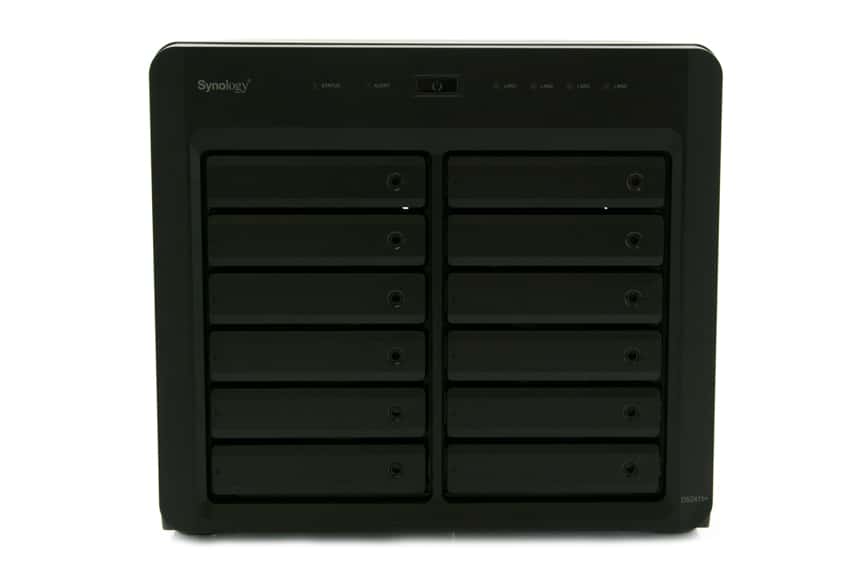
Like all of Synology’s DiskStation servers, the DS2415+ is comprehensive storage solution that includes all of the functions necessary to serve most businesses. Synology reports that the DS2415+ delivers encrypted transfers at 450MB/s read and 198MB/s write, and its quad LAN ports help minimize downtown in the event of connection malfunctions. SSD cache technology allows users to combine the use of hard drives and solid state drives depending on the use case. Synology’s DiskStation Manager (DSM) gives users an easy-to-use browser based interface through which they can manage the DS2415+.
The DS2415+ carries a price tag of $1,499.99 and comes with a 3-year warranty.
Specifications
- CPU Model: Intel Atom C2538
- CPU Frequency: Quad Core 2.4GHz
- Memory: 2GB DDR3
- Drive Bays: 12
- Max Internal Capacity: 96TB
- External ports: USB 3.0 x4
- Compatible Drive Types
- 3.5″ SATA(III)/SATA(II) HDD
- 2.5″ SATA(III)/SATA(II) HDD
- 2.5″ SATA(III)/SATA(II) SSD
- Dimensions: 270mm x 300mm x 340mm
- Weight: 9.24kg
- System Fan: 120mm x 120mm x 2pcs
- Power
- Power Supply: 500W
- AC Input Power Voltage: 100V to 240V AC
- Power Frequency: 50/60Hz, Single Phase
- Power Consumption
- 73.44W (Access)
- 37.13W (HDD Hibernation)
- Environmental
- Operating Temperature: 5ºC to 35ºC (40ºF to 95ºF)
- Storage Temperature: -20ºC to 60ºC (-5ºF to 140ºF)
- Noise Level: 18.1dB
- Relative Humidity: 5% to 95%
- Certifications: FCC Class B, CE Class B, BSMI Class B
- Warranty: 3 years
Design and Build
The DS2415+ is Synology’s largest available DiskStation configuration, and its physical footprint shows that. It has two columns with six bays each and the drives oriented horizontally with status LEDs the right of each bay. The face of the drive is encompassed mostly by the drive bays, but there is also some branding, a power button, and LEDs corresponding to system status, system alerts, and connectivity status for each of the four LAN ports.
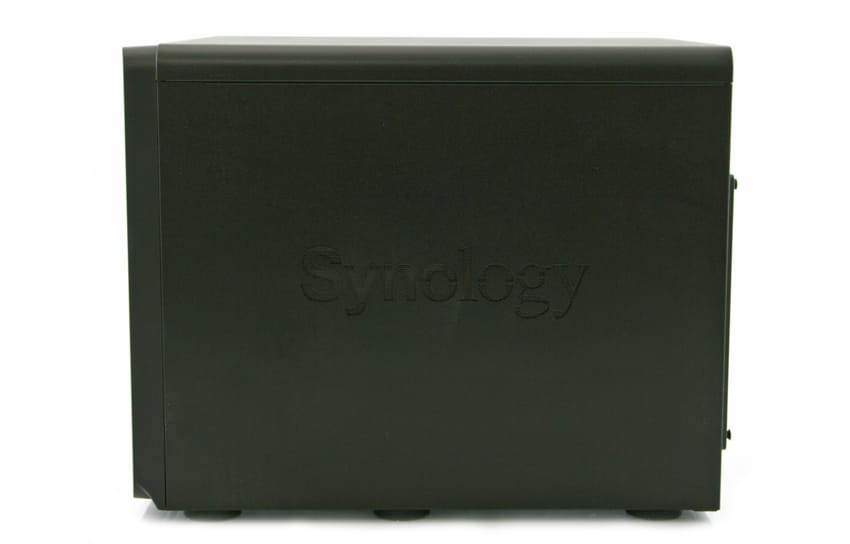
The back of the DS2415+ has two large fans lined up horizontally, four USB 3.0 ports, four LAN ports, a reset button, and the AC adaptor port.
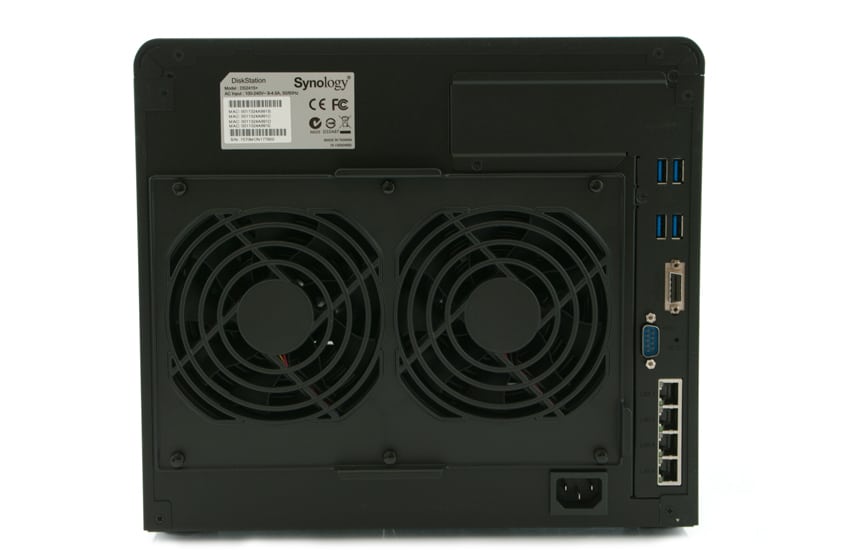
Testing Background and Comparables
We publish an inventory of our lab environment, an overview of the lab’s networking capabilities, and other details about our testing protocols so that administrators and those responsible for equipment acquisition can fairly gauge the conditions under which we have achieved the published results. None of our reviews are paid for or overseen by the manufacturer of equipment we are testing.
We tested both CIFS and iSCSI performance using RAID10 configurations of the WD Red NASware 3.0 6TB and compared the DS2415+ to Synology’s DS1815+.
Enterprise Synthetic Workload Analysis
Our enterprise hard drive benchmark process preconditions each drive into steady-state with the same workload the device will be tested with under a heavy load of 16 threads with an outstanding queue of 16 per thread, and then tested in set intervals in multiple thread/queue depth profiles to show performance under light and heavy usage. Since hard drives reach their rated performance level very quickly, we only graph out the main sections of each test.
Preconditioning and Primary Steady-State Tests:
- Throughput (Read+Write IOPS Aggregate)
- Average Latency (Read+Write Latency Averaged Together)
- Max Latency (Peak Read or Write Latency)
- Latency Standard Deviation (Read+Write Standard Deviation Averaged Together)
Our Enterprise Synthetic Workload Analysis includes four profiles based on real-world tasks. These profiles have been developed to make it easier to compare to our past benchmarks as well as widely-published values such as max 4k read and write speed and 8k 70/30, which is commonly used for enterprise drives.
- 4k
- 100% Read or 100% Write
- 100% 4k
- 8k 70/30
- 70% Read, 30% Write
- 100% 8k
- 128k (Sequential)
- 100% Read or 100% Write
- 100% 128k
In the first of our enterprise workloads, we measured a long sample of random 4k performance with 100% write and 100% read activity using the CIFS protocol. The DS2415+ outpaced the DS1815+ in write functions (2,520 IOPS vs. 1,862 IOPS, respectively), but not in read functions (438 IOPS vs. 384 IOPS, respectively).
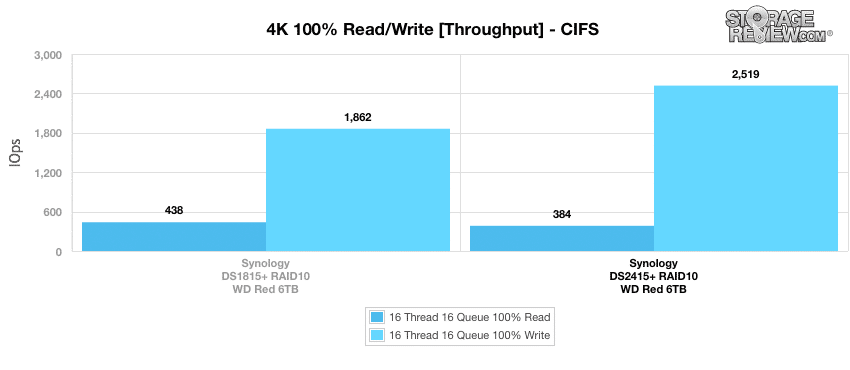
The performance profile of the iSCSI benchmark was similar to CIFS, although the numbers were higher in general; the DS2415+ posted a stronger write performance than the DS1815+ (1,524 IOPS vs. 1,125 IOPS, respectively), but fell short in read performance (754 IOPS vs. 1,870 IOPS, respectively).
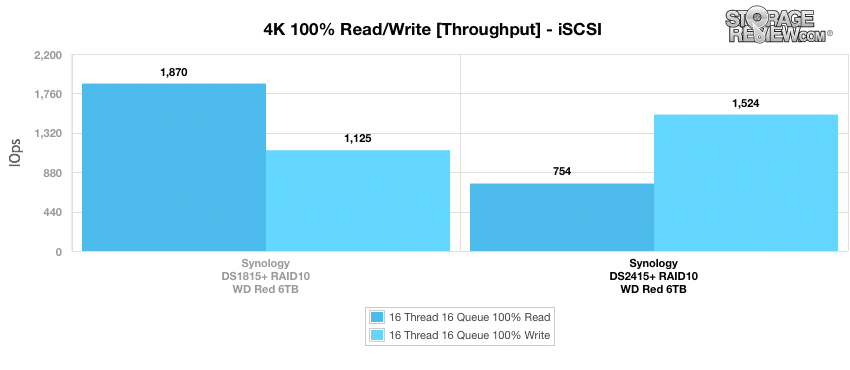
Moving to the latency segment with a load of 16T/16Q, the DS2415+ posted a read latency of 665ms and a write latency of 101.6ms, whereas the DS1815+ posted 584.6ms and 137.5ms, respectively.
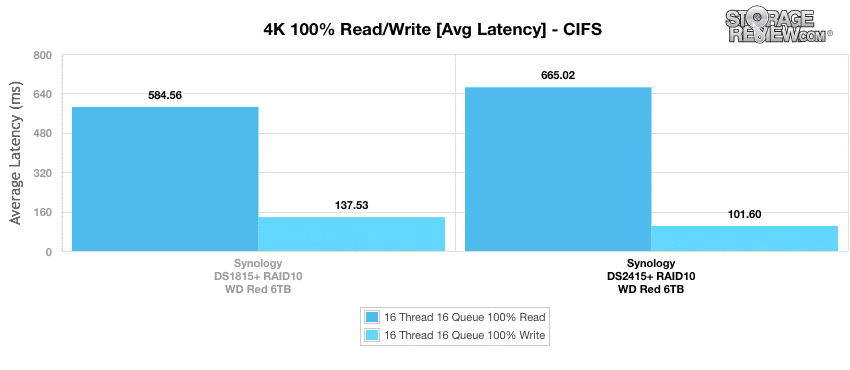
Using the iSCSI block-level test for the same benchmark shows the same distribution with very similar numbers. The read latency in iSCSI was lower than in CIFS (339.3ms for the DS2415+), and the write latency was higher (167.8ms for the DS2415+).
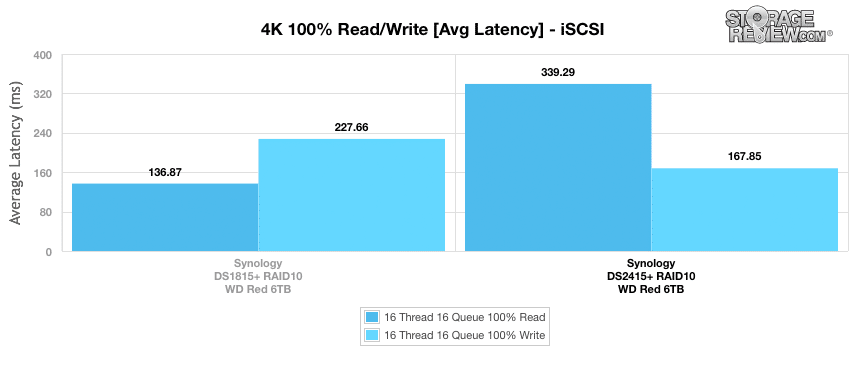
In the maximum 4k latency benchmark in the CIFS file-level test, the DS2415+ posted higher latencies than the DS1815+ in both read and write, with 3,489ms and 2,803ms, respectively.
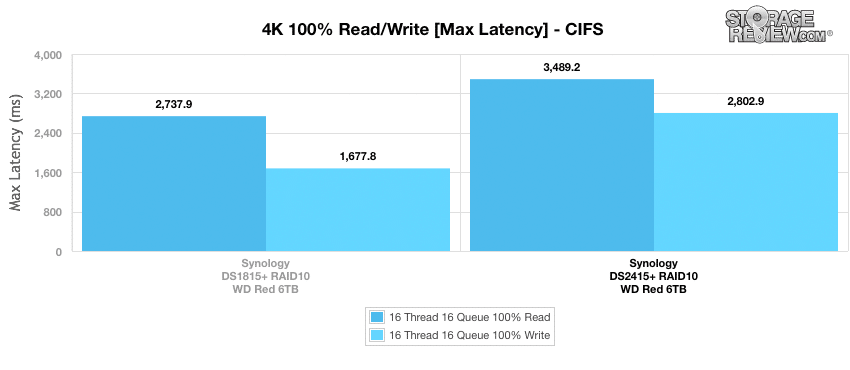
When configured in iSCSI, the DS2415+ posted a much better write latency (1,209ms), edging out the DS1815+ (1,773ms), but its read latency was still quite high compared to the DS1815+ (3,655ms vs. 895ms, respectively).
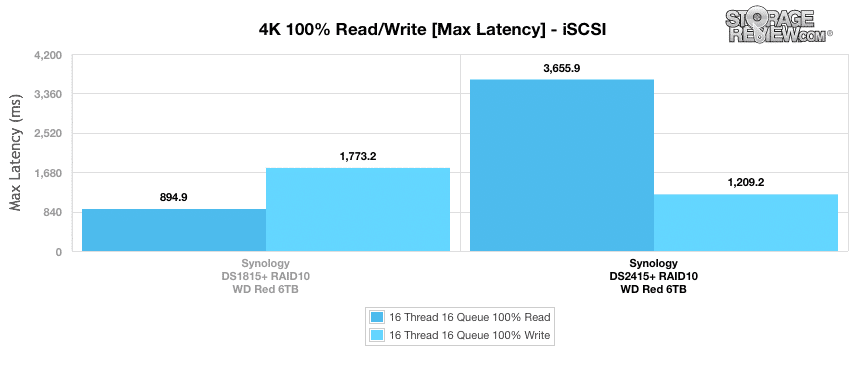
Calculating the DS1815+’s standard deviation for the 4k latency allows us to show how consistent the latency results were within each of the categories during our benchmarks. When looking at the CIFS configuration, the results for the DS1815+ and DS2415+ were very similar, with the latter posting 755.8ms read and 158.8ms write.
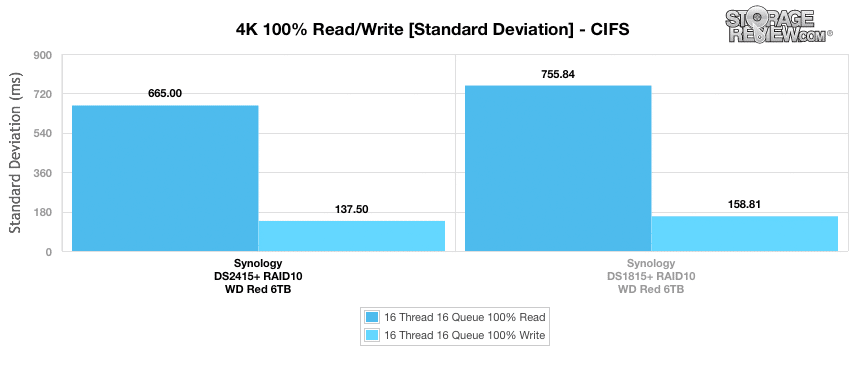
The iSCSI configuration posted fairly different results: the DS2415+ fell behind the DS1815+ in terms of read latency (391ms vs. 103.5ms, respectively), but posted a much better write latency (135.5ms vs. 280ms, respectively).
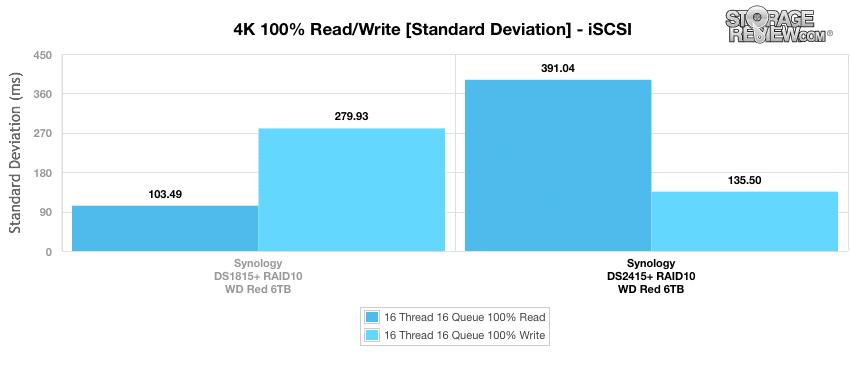
In our next set of benchmarks, we double the transfer size to 8k. In our CIFS benchmark, the DS2415+ posted 57,150 IOPS in read functions and 39,450 IOPS in write functions. The DS1815+ posted similar numbers, though it was slightly weaker in terms of read functions and stronger in terms of write functions.
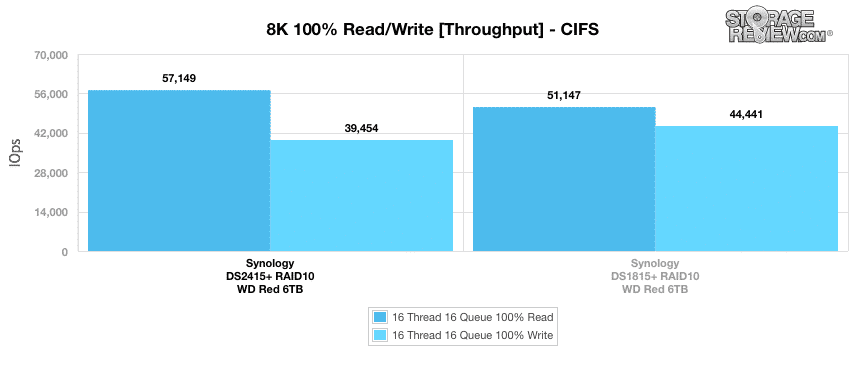
The DS2415+ performed well when configured in iSCSI, posting 26,836 IOPS and 21,738 IOPS in read and write, respectively. The DS1815+ took a hit on read performance (7,000 IOPS) but slightly outpaced the DS2415+ in write performance (24,440 IOPS).
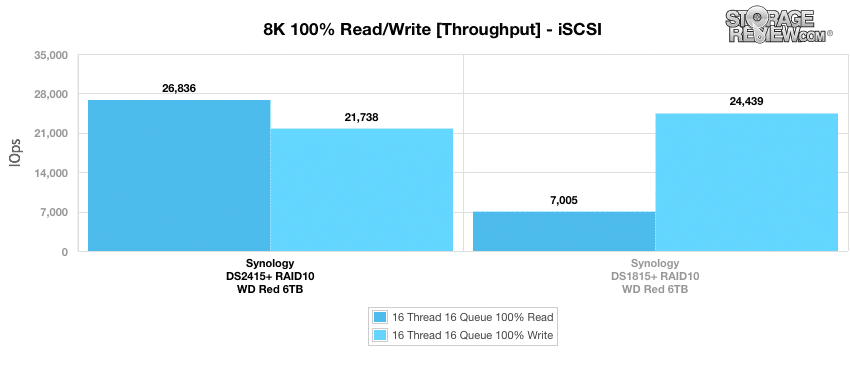
The next four charts are based on a protocol consisting of 70% read operations and 30% write operations with an 8k transfer size. The workload is then varied from 2 threads and a queue depth of 2 up to 16 threads and 16 queue. The DS1815+ outperformed the DS2415+ for the duration of our CIFS file-level test.
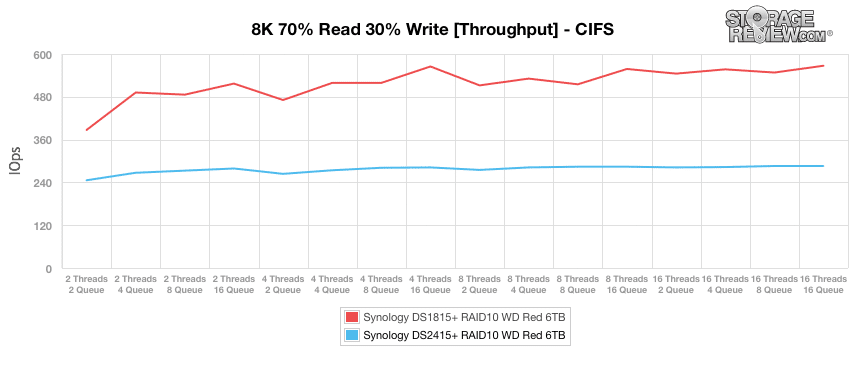
The DS1815+ exhibited performance spikes when configured in iSCSI, whereas the DS2415+ posted a more consistent performance. However, the DS1815+ still outperformed the DS2415+ for most of the test.
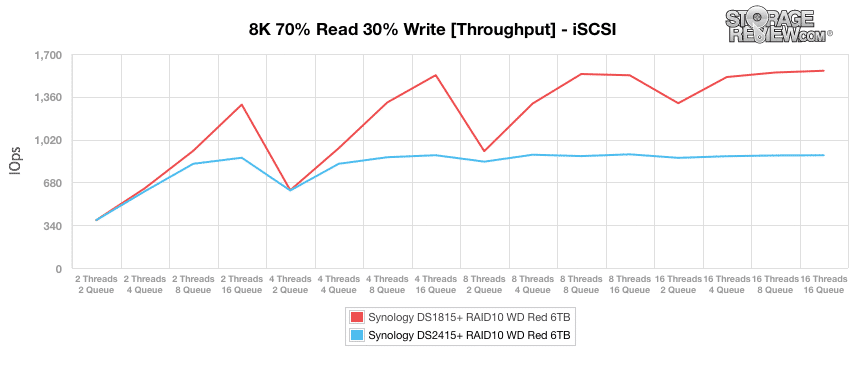
In terms of average latency, the DS1815+ once again outperformed the DS2415+ when configured in CIFS, although their numbers were fairly similar.
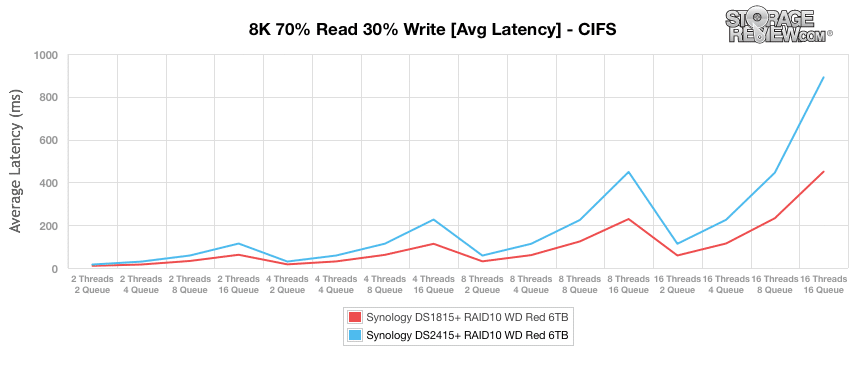
The results for our iSCSI average latency benchmark were similar, but the two servers had slightly closer numbers than in the CIFS test.
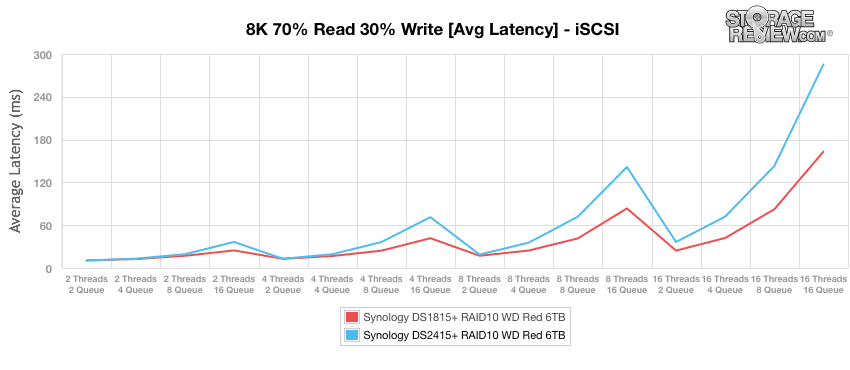
The DS2415+ performed very well in our CIFS-configured max latency benchmark, handedly outperforming the DS1815+ for the duration of the test.
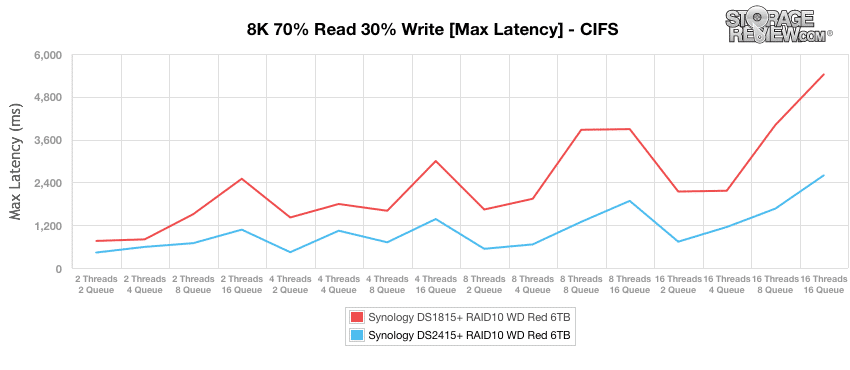
After switching to iSCSI, the DS2415+ fell behind the DS1815+ in terms of max latency.
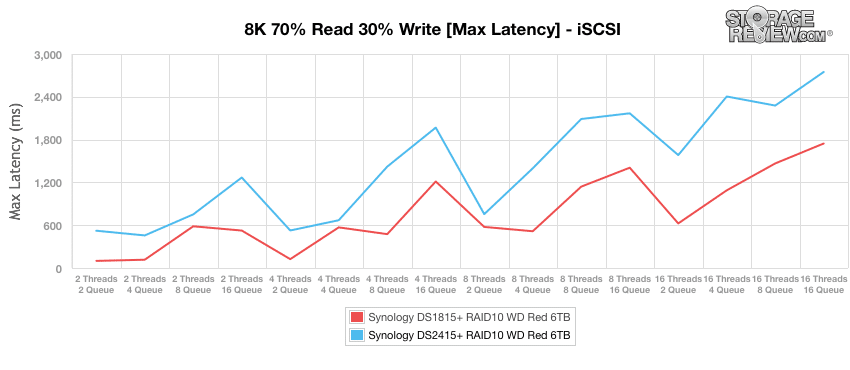
When configured in CIFS and looking at standard deviation, the two servers exhibited performances that were almost indistinguishable from each other.
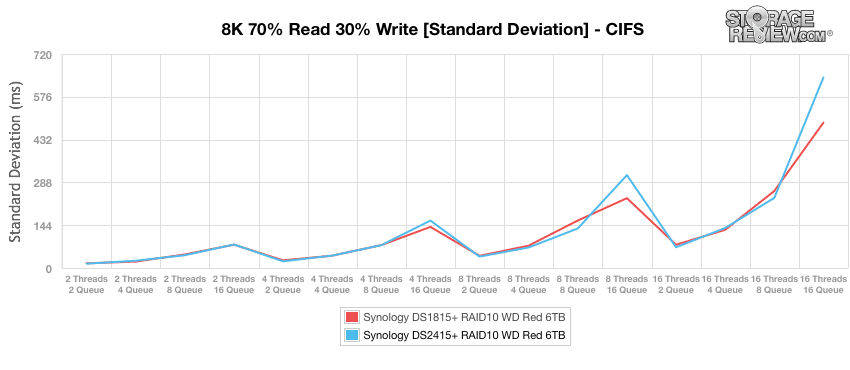
For the final mixed workload benchmark (iSCSI), the DS1815+ posted a slightly better performance than the DS2415+ in terms of standard deviation.
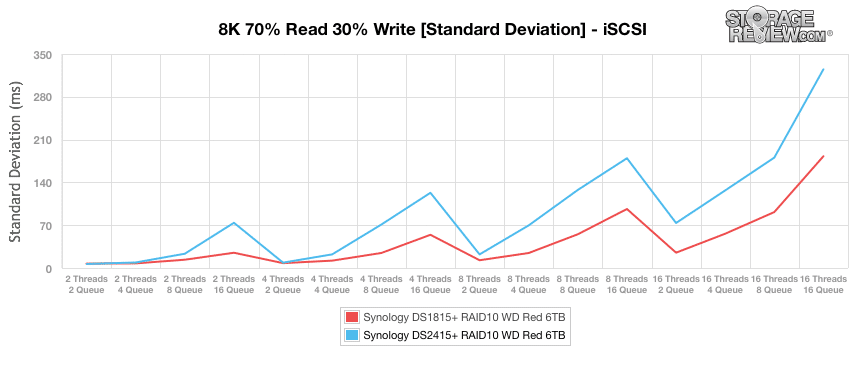
The final synthetic benchmark utilizes much larger 128k transfer sizes with 100% read and 100% write operations. The two servers had similar numbers across the board when configured in CIFS. The DS2415+ posted 462,655KB/s in read and 452,325KB/s in write (which was about 7,000KB/s higher than the write performance of the DS1815+).
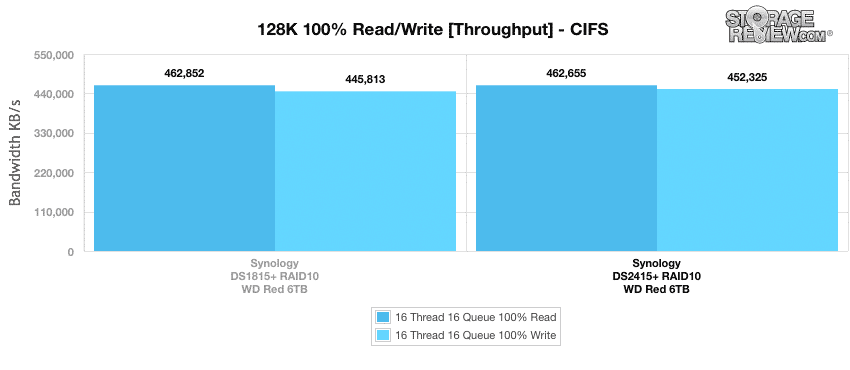
When the servers were configured in iSCSI, the DS2415+ outperformed the DS1815+ by a wide margin, especially in read functions; the DS2415+ posted 459,000KB/s in read and 439,800KB/s in write, whereas the DS1815+ only posted 193,000KB/s in read and 383,800KB/s in write.
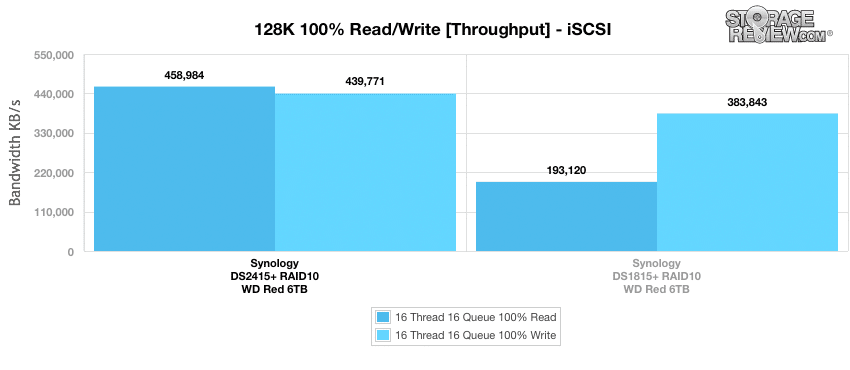
Conclusion
The DS2415+ features the largest configuration of any of Synology’s DiskStations while also leveraging a 2.4GHz CPU and up to 6GB of RAM. If Synology’s DX1215 expansion unit is used, the total raw capacity of the DS2415+ is 144TB. The DS2415+ includes all of the normal functionality of Synology’s DiskStations (e.g., DSM, CMS, encrypted transfers, virtualization capabilities), in addition to SSD cache technology and four USB 3.0 ports.
In terms of performance, the DS2415+ holds up unevenly when compared to Synology’s 8 bay DS1815+. In general, the DS2415+ tends to excel in write functions, especially when configured in CIFS. In our 4k tests the DS2415+ gave us write throughput of 2,519 IOPS CIFS and 1,524 IOPS iSCSI. The DS2415+ was slightly weaker in some of the mixed workload benchmarks when compared to the DS1815+. The DS2415+ exhibited much higher numbers than the DS1815+ in our 128k benchmark when configured in iSCSI, hitting speeds of 459MB/s read and 440MB/s write.
Pros
- Easy to use tower form factor
- Decent capacity/performance ratio
- Can grow capacity via expansion chassis
Cons
- Uneven performance
The Bottom Line
Synology’s DS2415+ is a high performing scalable 12-bay NAS with all of the features provided by DiskStation Manager, making it a strong option for larger businesses that are looking for a comprehensive storage solution.
Synology DiskStation DS2415+ at Amazon



 Amazon
Amazon